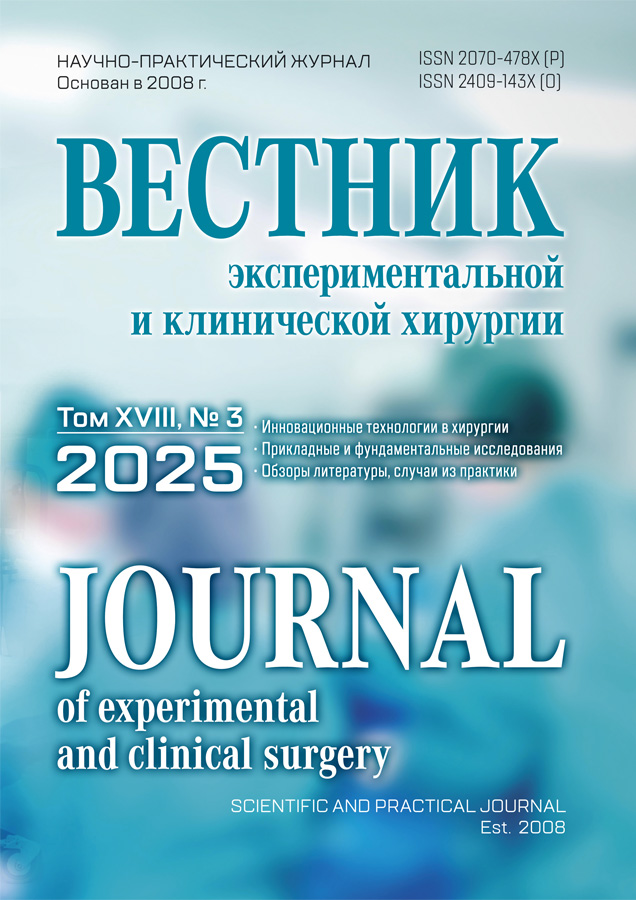Pancreaticoduodenectomy in a soft pancreas
- Authors: Galkin V.N.1, Kriger A.G.1,2, Gorin D.S.1, Pronin N.A.3, Panteleev V.I.4, Goev A.A.1,5, Martirosyan T.A.6,7, Galkin G.V.8, Ahtanin E.A.1, Sokolov A.A.1
-
Affiliations:
- Moscow City Hospital named after S.S. Yudin, Moscow Healthcare Department
- Russian Medical Academy of Continuing Medical Education of the Ministry of Health of the Russian Federation
- Ryazan State Medical University named after academician I.P. Pavlov
- Russian University of Economics named after G.V. Plekhanov
- State University of Education
- Moscow City Hospital named after S.S. Yudin, Moscow Healthcare Department
- A.V. Vishnevsky National Medical Research Center
- Moscow City Hospital named after S.S. Yudin
- Issue: Vol 18, No 3 (2025)
- Pages: 177-187
- Section: Original articles
- URL: https://vestnik-surgery.com/journal/article/view/1858
- DOI: https://doi.org/10.18499/2070-478X-2025-18-3-177-187
- ID: 1858
Cite item
Abstract
Aim. To evaluate the effects of different techniques of the pancreaticoduodenectomy (PD) on the frequency and severity of postoperative complications and mortality in patients with a "soft" pancreas.
Material and methods. The results of 141 PDs were evaluated (76 were exposed the conventional surgery and 65 were exposed to the expanded volume of pancreatic resection, considering angioarchitectonics). In all cases, the pancreas was "soft", which was confirmed by morphological examination. The arterial architectonics of the cephalocervical segment of the pancreas was studied in the anatomical part of the study on 94 preparations, as well as clinical and radiological examination in 62 people.
Results. In patients with "soft" pancreas, an increased volume of resection during PD, considering arterial architectonics in the cervical region, allowed for a slight improvement in the immediate results of the operation: the number of specific postoperative complications decreased from 51.3% to 43.1%, mortality decreased from 7.9% to 4.6%. The probability of a postoperative pancreatic fistula (POPF) increased in cases where the dorsal pancreatic artery was not a branch of the splenic artery. The formation of an anastomosis with a pancreatic stump on an isolated loop and the preservation of the gastrointestinal ligament at the stage of mobilization reduced the aggressiveness of postoperative complications.
Conclusion. The expanded volume of pancreatic resection to ensure adequate blood supply of the stump of the organ appears to be an effective option only in cases of dorsal pancreatic artery withdrawal from the splenic artery. It is not possible to avoid ischemia of the pancreatic stump in other variants of the arterial anatomy of this vessel. In case of POPF, reconstruction involving two loops of the jejunum can reduce its aggressiveness. Mobilization of the complex with preservation of the gastrointestinal ligament facilitates the identification of the superior mesenteric vein and reduces the frequency of gastrostasis in the postoperative period.
Keywords
Full Text
About the authors
Vsevolod Nikolaevich Galkin
Moscow City Hospital named after S.S. Yudin, Moscow Healthcare Department
Author for correspondence.
Email: vsgalkin@gmail.com
M.D., Professor, Chief Medical Officer
Russian Federation, MoscowAndrey Germanovich Kriger
Moscow City Hospital named after S.S. Yudin, Moscow Healthcare Department; Russian Medical Academy of Continuing Medical Education of the Ministry of Health of the Russian Federation
Email: krigerAG@zdrav.mos.ru
M.D., Professor, Chief Researcher, Professor of the Department of Emergency and General Surgery named after Professor A.S. Ermolov
Russian Federation, Moscow; MoscowDavid Semenovich Gorin
Moscow City Hospital named after S.S. Yudin, Moscow Healthcare Department
Email: davidc83@mail.ru
M.D., Chief
Russian Federation, MoscowNikolay Alekseevich Pronin
Ryazan State Medical University named after academician I.P. Pavlov
Email: proninnikolay@mail.ru
Ph.D., Docent of Anatomy Department
Russian Federation, RyazanVladmir Igorevich Panteleev
Russian University of Economics named after G.V. Plekhanov
Email: vpantel@mail.ru
Ph.D., senior researcher at the scientific laboratory of health informatics and economy in healthcare
Russian Federation, MoscowAlexander Alexandrovich Goev
Moscow City Hospital named after S.S. Yudin, Moscow Healthcare Department; State University of Education
Email: a_goev@mail.ru
Ph.D., surgeon in the Surgery Department №5, Associate Professor
Russian Federation, Moscow; MoscowTigran Artashesovich Martirosyan
Moscow City Hospital named after S.S. Yudin, MoscowHealthcare Department; A.V. Vishnevsky National Medical Research Center
Email: robatik2015@gmail.com
surgeon, resident of Abdominal
Russian Federation, Moscow; MoscowGleb Vsevolodovich Galkin
Moscow City Hospital named after S.S. Yudin
Email: igkebgalkin@gmail.com
surgeon in the Surgery Department №5
Russian Federation, MoscowEvgeniy Alexandrovich Ahtanin
Moscow City Hospital named after S.S. Yudin, Moscow Healthcare Department
Email: ahtanin.evgenii@mail.ru
Ph.D., Head of Surgery Department №1
Russian Federation, MoscowAlexander Alexandrovich Sokolov
Moscow City Hospital named after S.S. Yudin, Moscow Healthcare Department
Email: alexandrklv@gmail.com
Head of the Ultrasound Department
Russian Federation, MoscowReferences
- Nagtegaal ID, Odze RD, Klimstra D, Paradis V, Rugge M, Schirmacher P, Washington KM, Carneiro F, Cree IA, WHO Classification of Tumours Editorial Board. The 2019 WHO classification of tumours of the digestive system. Histopathology. 2019;75(2):182-188. doi: 10.1111/his.13975
- Mizrahi JD, Surana R, Valle JW, Shroff RT. Pancreatic cancer. Lancet. 2020;395(10242):2008-2020. doi: 10.1016/S0140-6736(20)30974-0.
- Shams MA, Sutcliffe RP. Total pancreatectomy in patients at high risk of postoperative pancreatic fistula (POPF). Gland Surg. 2024;13(6):1141-1143. doi: 10.21037/gs-24-86.
- Krieger AG. Khirurgicheskaya pankreatologiya. Moscow: RIA "Vneshtorgizdat". 2021; 332. ISBN 978-5-9022-71-35-2. (in Russ.)
- Kriger AG, Pronin NA, Dvukhzhilov MV, Shulutko AM, Galkin GV, Gorin DS. Surgical view on the arterial anatomy of the pancreas. Annaly khirurgicheskoi gepatologii. 2021;26(3):112-122. doi: 10.16931/1995-5464.2021-3-112-122. (in Russ.)
- Solodkii VA, Kriger AG, Gorin DS, Pronin NA, Dvukhzhilov MV, Galkin GV. Pancreatoduodenal resection — results and prospects (a two-center study). Khirurgiya. Zhurnal im N.I. Pirogova. 2023;(5):13-21. doi: 10.17116/hirurgia202305113. (in Russ.)
- Pronin NA. Dorsal pancreatic artery: frequency, morphometry, origin, course, branches. Sibirskii nauchnyi meditsinskii zhurnal. 2024;44(3):29-40. doi: 10.18699/SSMJ20240303. (in Russ.)
- Gorin DS, Kriger AG, Galkin GV, Pronin NA, Dvukhzhilov MV, Shulutko AM Prediction of pancreatic fistula after pancreatoduodenal resection. Khirurgiya. Zhurnal im N.I. Pirogova. 2020;(7):61-67. doi: 10.17116/hirurgia202007161. (in Russ.)
- Karachun AM, Kashchenko VA, Pelipas' YuV. Technical aspects of laparoscopic interventions for gastric cancer. Klinicheskaya Bol'nitsa. 2016; 2(16): 6-19. https://med122.ru/news/1/Magazine_2_2016.pdf. (in Russ.)
- Revishvili ASh, Olovyannyi VE, Gogiya BSh, Kriger AG, Galkin GV, Gorin DS. Khirurgicheskaya pomoshch' v Rossiyskoy Federatsii. M. 2024; 192. ISBN 978-5-6043874-3-6. https://anyflip.com/nvzse/ojni/. (in Russ.)
- Bertelli E, Di Gregorio F, Mosca S, Bastianini A. The arterial blood supply of the pancreas: a review. V. The dorsal pancreatic artery. An anatomic review and a radiologic study. Surg Radiol Anat. 1998;20(6):445-452. doi: 10.1007/BF01653138.
- Jiang CY, Liang Y, Chen YT, Wang ZX, Zhao YP, Zhou J. The anatomical features of dorsal pancreatic artery in the pancreatic head and its clinical significance in laparoscopic pancreatoduodenectomy. Surg Endosc. 2021;35(2):569-575. doi: 10.1007/s00464-020-07417-7.
- Matveeva LV, Usanova AA, Mosina LM. Fiziologiya zheludka: monografiya. Saransk. 2012; 100. (in Russ.)
- Kuemmerli C, Rоssler F, Berchtold C, Mehrabi A, Muller-Stich BP, Hackert T. Artificial intelligence in pancreatic surgery: current applications. J Pancreatol. 2023;6(2):74-81. doi: 10.1097/JP9.0000000000000129.
- Han IW, Cho K, Ryu Y, Jang JY, Kim SW. Risk prediction platform for pancreatic fistula after pancreatoduodenectomy using artificial intelligence. World J Gastroenterol. 2020;26(30):4453-4464. doi: 10.3748/wjg.v26.i30.4453.
- Ashraf Ganjouei A, Romero-Hernandez F, Wang JJ, Conroy PC, Hirose K, Corvera CU. A Machine Learning Approach to Predict Postoperative Pancreatic Fistula After Pancreaticoduodenectomy Using Only Preoperatively Known Data. Ann Surg Oncol. 2023;30(12):7738-7747. doi: 10.1245/s10434-023-14041-x.
- Shen Z, Chen H, Wang W, Zhao L, Li G, Cai B. Machine learning algorithms as early diagnostic tools for pancreatic fistula following pancreaticoduodenectomy and guide drain removal: A retrospective cohort study. Int J Surg. 2022;102:106638. doi: 10.1016/j.ijsu.2022.106638.
Supplementary files






















